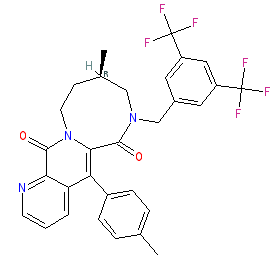|
Synonyms: compound (aR,9R)-8b [PMID: 10508446] | TAK 637 | TAK637
Compound class:
Synthetic organic
Comment: TAK-637 was developed as a tachykinin 1 (NK1) receptor antagonist, and identified as a clinical candidate for the treatment of bladder function disorders [2-3]. TAK-637 is now available for repurposing via the MRC-Industry Asset Sharing Initiative 2016 (full compound list).
Ligand Activity Visualisation ChartsThese are box plot that provide a unique visualisation, summarising all the activity data for a ligand taken from ChEMBL and GtoPdb across multiple targets and species. Click on a plot to see the median, interquartile range, low and high data points. A value of zero indicates that no data are available. A separate chart is created for each target, and where possible the algorithm tries to merge ChEMBL and GtoPdb targets by matching them on name and UniProt accession, for each available species. However, please note that inconsistency in naming of targets may lead to data for the same target being reported across multiple charts. ✖ |
|
|||||||||||||||||||||||||||||||||||
| No information available. |
Mechanism Of Action and Pharmacodynamic Effects  |
| Substance P activates the NK1 receptor bringing about a number of biological effects in central and peripheral tissues. Antagonists which inhibit the effects of endogenous substance P are regarded as having potential clinical utility in the treatment of pain, inflammation, rheumatoid arthritis, asthma, emesis, migraine, depression and bladder function disorders (e.g. urinary incontinence). In preclinical experiments TAK-637 increases increase the interval time of bladder contractions and bladder storage function (bladder volume threshold) [1,3], which in humans could translate to improved control of stress (urge) incontinence. |







